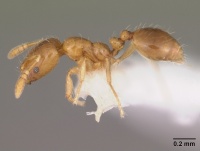Monomorium termitobium
| Monomorium termitobium | |
|---|---|

| |
| Scientific classification | |
| Kingdom: | Animalia |
| Phylum: | Arthropoda |
| Class: | Insecta |
| Order: | Hymenoptera |
| Family: | Formicidae |
| Subfamily: | Myrmicinae |
| Tribe: | Solenopsidini |
| Genus: | Monomorium |
| Species: | M. termitobium |
| Binomial name | |
| Monomorium termitobium Forel, 1892 | |
| Synonyms | |
| |
Madagascar's most common Monomorium species. It is found in many habitats and has been captured using a range of collection methods.
Identification
Heterick (2006) - A member of the M. rhopalocerum complex in the M. monomorium species group. The array of diverse forms has a few worker characters that separate them from similar but more easily recognized species. The mandible always has four teeth, and the basal tooth is usually about the same size as or slightly smaller than the preceding tooth, rarely being reduced to a minute denticle (unlike Monomorium flavimembra). The diameter of the eye is between one and one-and-a-half times the greatest width of the antennal scape and has 10 or more ommatidia in all except a tiny handful of specimens with a brownish cast to their head capsules (distinguishing workers of this species from those of Monomorium micrommaton). Commonly, there is a peripheral ring of ommatidia with a central row of two or three ommatidia, but two or more rows may be present. Workers with a light-colored head and mesosoma and dark gaster always have narrowly separated and well-defined clypeal carinae, setting them apart from Monomorium lepidum.
Keys including this Species
- Key to Afrotropical Erromyrma, Monomorium, Syllophopsis and Trichomyrmex species
- Key to Malagasy Erromyrma, Monomorium, Syllophopsis and Trichomyrmex species
Distribution
Latitudinal Distribution Pattern
Latitudinal Range: -12.501401° to -34.26267°.
| North Temperate |
North Subtropical |
Tropical | South Subtropical |
South Temperate |
- Source: AntMaps
Distribution based on Regional Taxon Lists
Afrotropical Region: Botswana, Comoros, South Africa, Zimbabwe.
Malagasy Region: Madagascar (type locality), Mayotte.
Distribution based on AntMaps
Distribution based on AntWeb specimens
Check data from AntWeb
Countries Occupied
| Number of countries occupied by this species based on AntWiki Regional Taxon Lists. In general, fewer countries occupied indicates a narrower range, while more countries indicates a more widespread species. |

|
Estimated Abundance
| Relative abundance based on number of AntMaps records per species (this species within the purple bar). Fewer records (to the left) indicates a less abundant/encountered species while more records (to the right) indicates more abundant/encountered species. |

|
Biology
Castes
Worker
Images from AntWeb
   
| |
| Worker. Specimen code casent0003327. Photographer April Nobile, uploaded by California Academy of Sciences. | Owned by CAS, San Francisco, CA, USA. |
   
| |
| Worker. Specimen code casent0003992. Photographer April Nobile, uploaded by California Academy of Sciences. | Owned by CAS, San Francisco, CA, USA. |
   
| |
| Worker. Specimen code casent0076204. Photographer Michele Esposito, uploaded by California Academy of Sciences. | Owned by CAS, San Francisco, CA, USA. |
  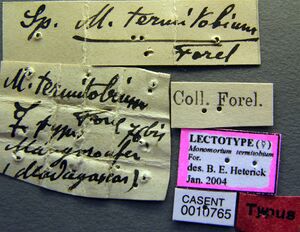
| |
| Specimen code casent0010765. . | |
Additional images can be found here
Queen
Images from AntWeb
   
| |
| Queen (alate/dealate). Specimen code casent0107081. Photographer April Nobile, uploaded by California Academy of Sciences. | Owned by CAS, San Francisco, CA, USA. |
   
| |
| Queen (alate/dealate). Specimen code casent0109632. Photographer April Nobile, uploaded by California Academy of Sciences. | Owned by CAS, San Francisco, CA, USA. |
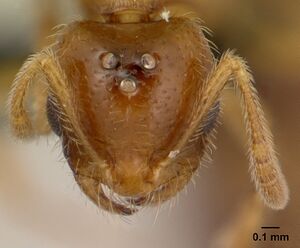   
| |
| Queen (alate/dealate). Specimen code casent0132542. Photographer Erin Prado, uploaded by California Academy of Sciences. | Owned by CAS, San Francisco, CA, USA. |
Male
Images from AntWeb
   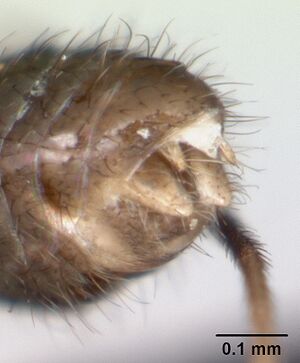  
| |
| Male (alate). Specimen code casent0049558. Photographer April Nobile, uploaded by California Academy of Sciences. | Owned by CAS, San Francisco, CA, USA. |
    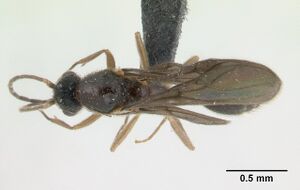 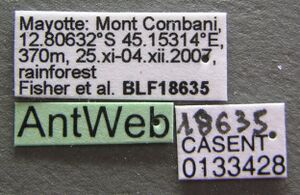
| |
| Male (alate). Specimen code casent0133428. Photographer Erin Prado, uploaded by California Academy of Sciences. | Owned by CAS, San Francisco, CA, USA. |
    
| |
| Male (alate). Specimen code casent0460162. Photographer April Nobile, uploaded by California Academy of Sciences. | Owned by CAS, San Francisco, CA, USA. |
Nomenclature
The following information is derived from Barry Bolton's Online Catalogue of the Ants of the World.
- termitobium. Monomorium termitobium Forel, 1892k: 522 (w.) MADAGASCAR.
- Type-material: lectotype worker (lacks head) (by designation of Heterick, 2006: 140).
- Type-locality: Madagascar: Mangoroafa (?) (Sikora).
- [Note: published locality is Amparafaravantsiv; the disparity is not explained.]
- Type-depository: MHNG
- Heterick, 2006: 143 (q.m.).
- Status as species: Wasmann, 1894: 166; Emery, 1922e: 173; Wheeler, W.M. 1922a: 1027; Ettershank, 1966: 92; Bolton, 1995b: 267; Heterick, 2006: 140 (redescription).
- Senior synonym of binatu: Heterick, 2006: 140.
- Senior synonym of exchao: Heterick, 2006: 140.
- Senior synonym of imerinense: Heterick, 2006: 140.
- Distribution: Madagascar, South Africa.
- binatu. Monomorium binatu Bolton, 1987: 380, fig. 78 (w.) ZIMBABWE.
- Type-material: holotype worker, 16 paratype workers.
- Type-locality: holotype Zimbabwe (“Rhodesia”): Vumba Mts, nr Umtali, 11.ii.1969 (W.L. Brown); paratypes with same data.
- Type-depositories: MCZC (holotype); BMNH, MCZC (paratypes).
- Status as species: Bolton, 1995b: 260.
- Junior synonym of termitobium: Heterick, 2006: 140.
- exchao. Monomorium exchao Santschi, 1926b: 235 (w.) SOUTH AFRICA.
- Type-material: lectotype worker (by designation of Heterick, 2006: 140), 1 paralectotype worker.
- Type-locality: lectotype South Africa: Cape Colony, Grahamstown, Paradise Kloof, xii.1919 (J. Hewitt); paralectotype with same data.
- Type-depository: NHMB.
- Status as species: Ettershank, 1966: 89; Bolton, 1987: 387 (redescription); Bolton, 1995b: 261.
- Junior synonym of termitobium: Heterick, 2006: 140.
- imerinense. Monomorium minutum r. imerinense Forel, 1892l: 257 (q.m.) MADAGASCAR.
- Type-material: lectotype queen (by designation of Heterick, 2006: 140), 2 paralectotype queens, 1 paralectotype male.
- Type-locality: Madagascar: Forêt d’Andrangoloaka (Sikora); paralectotypes with same data.
- Type-depository: MHNG.
- Distribution: Madagascar.
- Subspecies of minutum: Dalla Torre, 1893: 67; Wheeler, W.M. 1922a: 1027; Emery, 1922e: 172; Ettershank, 1966: 89.
- Status as species: Bolton, 1995b: 262; Bolton, 1995b: 262.
- Junior synonym of termitobium: Heterick, 2006: 140.
Unless otherwise noted the text for the remainder of this section is reported from the publication that includes the original description.
Heterick (2006) - Monomorium termitobium, as it is here understood, is not only the most abundant Monomorium species on Madagascar, often representing 80–90% of the Monomorium specimens in a given sample, but one that is almost intractable to taxonomic analysis based purely on morphology. Undoubtedly, a more definitive diagnosis of M. termitobium will require molecular analysis. However the species may finally be interpreted, Monomorium termitobium is unquestionably highly variable in appearance. Workers with shared morphological features often vary in their color, which ranges from bright yellow to deep chocolate. In many cases involving brown specimens, or specimens with a yellow mesosoma and a brown head, the antenna has a brown scape and a yellow funiculus. In workers with light colored foreparts the gaster can be completely yellow, infuscated to varying degrees, or completely black. The clypeal carinae can be strongly defined and parallel or subparallel, weakly defined or completely lacking, the anteromedian sector of the clypeus in the latter being somewhat bulging in appearance (as in M. micrommaton). The anteromedian clypeal margin is mostly emarginate in workers with strongly defined clypeal carinae and in a few bicolored workers with dark heads, but without strongly defined clypeal carinae, and straight or convex in the others. The promesonotum, viewed in profile, ranges from roundly convex to quite straight. The propodeum, also viewed in profile, may be rounded, roughly square or elongate. The petiolar node is most commonly broadly conical and tending to circular in cross-section, but may be narrowly cuneate or low, conical and tapered. Pilosity varies, the number of pairs of erect promesonotal setae ranging from three, e.g., brown and yellow specimens of Monomorium binatu from Toliara Province, to seven or more (the additional setae often being simply shorter and appressed rather than actually absent in the less ‘shaggy’ forms).
Description
Worker
Heterick (2006) - Lectotype (M. termitobium): Not taken, as the lectotype is headless. Lectotype (Monomorium exchao): HML 1.22 HL 0.48 HW 0.37 CeI 77 SL 0.34 SI 92 PW 0.24. (non-types): HML 0.86–1.54 HL 0.32–0.59 HW 0.25–0.50 CeI 74–90 SL 0.22–0.44 SI 76–109 PW 0.15–0.32 (n=200)
HEAD: Head square, or, rectangular; vertex planar or weakly concave; frons shining and smooth except for piliferous pits; pilosity of frons a mixture of well-spaced, distinctly longer erect and semi-erect setae interspersed with shorter decumbent setae or setulae. Eye moderate (rarely, small), eye width 1–1.5× greatest width of antennal scape; (in full-face view) eyes set below midpoint of head capsule; (viewed in profile) eye set around midline of head capsule, or, set posteriad of midline of head capsule; eye elliptical, curvature of inner eye margin may be more pronounced than that of its outer margin. Antennal segments 12; antennal club three-segmented. Clypeal carinae well-defined, weakly defined, or indistinct; anteromedian clypeal margin of variable appearance, ranging from broadly convex, or, narrowly convex between weakly ridged clypeal carinae, to straight, or, straight between strongly divergent clypeal carinae with clypeus descending almost vertically to horizontal arc of mandibles and sometimes transversely carinate below level of antennal insertions. Clypeus may also be emarginate, clypeal carinae indistinct or present and terminating in blunt angles. Paraclypeal setae moderately long and fine, curved; posteromedian clypeal margin extending slightly beyond level of posterior margin of antennal fossae. Anterior tentorial pits situated nearer antennal fossae than mandibular insertions. Frontal lobes sinuate, divergent posteriad. Psammophore absent. Palp formula 2,2. Mandibular teeth four, with basal tooth only slightly smaller than preceding three teeth, or, three, plus minute, apical denticle or angle; mandibles with sub-parallel inner and outer margins, smooth (except for piliferous pits); masticatory margin of mandibles approximately vertical or weakly oblique, to strongly oblique; basal tooth approximately same size as t3 (four teeth present), or, a small to minute denticle or angle, much smaller than t3 (four teeth present).
MESOSOMA: Promesonotum shining and either completely smooth, or, with faint punctation or striolae on lower anterior mesopleuron; (viewed in profile) promesonotal outline ranging from broadly convex to anterior promesonotum smoothly rounded, thereafter more-or-less flattened, with promesonotum on same plane as propodeum; promesonotal setae very variable, from seven or eight to more than a dozen; standing promesonotal setae a mixture of well-spaced, distinctly longer, erect and semi-erect setae which are curved distally and often paired, interspersed with much shorter, incurved, decumbent setae; appressed promesonotal setulae very sparse or absent. Metanotal groove strongly impressed, with distinct transverse costulae or weakly impressed, with faint costulae or costulae lacking. Propodeum shining and smooth, metapleuron with a few weak to strongly defined, longitudinal, hair-like striolae; propodeal dorsum convex to flat throughout most of its length; smoothly rounded or with indistinct angle; standing propodeal setae either (i) consisting of one prominent pair anteriad, with other shorter setae very sparse or absent, or, (ii) consisting of one prominent pair anteriad, with a few to many erect to decumbent setae on/around dorsal and declivitous faces of propodeum, or, (iii) consisting of two or more prominent pairs anteriad, often with another pair of prominent setae posteriad, and other smaller setae on/around dorsal and declivitous surfaces of propodeum; appressed propodeal setulae very sparse or absent; propodeal spiracle nearer metanotal groove than declivitous face of propodeum, or, equidistant from metanotal groove and declivitous face of propodeum; vestibule of propodeal spiracle absent or not visible; propodeal lobes either present as rounded flanges, or, present as vestigial flanges or small strips of cuticle only.
PETIOLE AND POSTPETIOLE: Petiolar spiracle lateral or laterodorsal and situated within anterior sector of petiolar node. Node (viewed in profile) cuneate with vertex tapered or rounded, or, conical with vertex tapered or rounded; appearance of node shining and smooth throughout; ratio of greatest node breadth (viewed from front) to greatest node width (viewed in profile) between 1:1 and 3:4. Anteroventral petiolar process either present as a thin flange tapering posteriad, or, absent or vestigial; ventral petiolar lobe present. Height ratio of petiole to postpetiole between 3:2 and 1:1; height–length ratio of postpetiole between 3:2 and 1:1; postpetiole shining and smooth; postpetiolar sternite not depressed at midpoint, its anterior end either an inconspicuous lip or small carina, or, this structure lacking or vestigial.
GASTER: Pilosity of first gastral tergite consisting of well-spaced, erect and semi-erect setae interspersed with a few appressed setulae, or, consisting of a mixture of incurved, semi-erect setae and slightly shorter decumbent setae.
GENERAL CHARACTERS: Color of foreparts yellow to chocolate, gaster of same color or darker, appendages yellowish to brown or bicolored (but not darker than mesosoma). Worker caste monomorphic.
Queen
Heterick (2006) - Lectotype (Monomorium imerinense): HML 2.36 HL 0.68 HW 0.67 CeI 99 SL 0.53 SI 79 PW 0.54. HML 1.61–2.53 HL 0.49–0.72 HW 0.42–0.65 CeI 83–98 SL 0.36–0.65 SI 77–94 PW 0.32–0.73 (n=62).
HEAD: Head square to rectangular; vertex weakly concave or planar; frons either completely shining and smooth except for piliferous pits, or, shining and smooth with a few striolae around antennal sockets and frontal carinae; pilosity of frons a mixture of well-spaced, distinctly longer erect and semi-erect setae interspersed with shorter setae or setulae, which are decumbent or appressed, longer setae thickest on vertex. Eye either more-or-less circular, or, elliptical, curvature of inner eye margin may be more pronounced than that of its outer margin; (in full-face view) eyes set at about midpoint to below midpoint of head capsule; (viewed in profile) eyes set around midline of head capsule to set posteriad of midline of head capsule.
MESOSOMA: Pronotum and anterior mesoscutum smoothly rounded, thereafter more-or-less flattened; mesoscutum and mesopleuron shining and mainly smooth, vestigial striolae, if present, confined to anterior katepisternum; length–width ratio of mesoscutum and scutellum combined between 7:3 and 3:2. Axillae variable, separation of axillae can range from width of at least one axilla to axillae contiguous, or nearly so. Standing pronotal/mesoscutal setae a mixture of well-spaced, distinctly longer, erect and semi-erect setae which are curved distally, interspersed with much shorter, incurved, decumbent setae; appressed pronotal, mescoscutal and mesopleural setulae few, mainly on sides of pronotum and mesopleuron. Propodeum shining and smooth, with multiple hair like striolae on metapleuron; propodeum smoothly rounded, with indistinct angle, or, angulate, propodeal angle blunt; propodeal dorsum either convex, or, flat throughout most of its length, or, slightly elevated anteriad and sloping away posteriad, propodeal angles not raised; standing propodeal setae consisting of up to a dozen or more longer erect and shorter sub-erect setae; appressed propodeal setulae very sparse or absent; propodeal spiracle nearer metanotal groove than declivitous face of propodeum, or, equidistant from metanotal groove and declivitous face of propodeum; propodeal lobes present as well-developed, rounded flanges, or, present as vestigial flanges only, or absent.
WING: Wing veins predominantly depigmented (wing membrane itself may have smoky tinge), with distal segments reduced to vestigial lines; vein m–cu always absent; vein cu–a absent.
PETIOLE AND POSTPETIOLE: Petiolar spiracle lateral and situated within anterior sector of petiolar node, or, lateroventral and situated within anterior sector of petiolar node; node, in profile, very variable, ranging from cuneate, vertex tapered or rounded, or, cuneate, vertex rounded and node inclined posteriad, to conical, vertex tapered or rounded; appearance of node shining and smooth, or, shining, with vestigial sculpture, or, shining and weakly striolate posteriad; ratio of greatest node breadth (viewed from front) to greatest node width (viewed in profile) between 3:2 and 1:1. Anteroventral petiolar process present as a thin flange tapering posteriad, or, absent or vestigial; height ratio of petiole to postpetiole between 3:2 and1:1; height–length ratio of postpetiole between 3:2 and1:1; postpetiole shining and smooth, or, shining, with vestigial sculpture, or, shining and weakly striolate posteriad; postpetiolar sternite not depressed, its anterior end an inconspicuous lip or small carina or this structure vestigial.
GASTER: Pilosity of first gastral tergite consisting of well-spaced, erect and semi-erect setae interspersed with a few appressed setulae, or, consisting of a mixture of incurved, erect and semierect setae and slightly shorter decumbent setae.
GENERAL CHARACTERS: Color of head and mesosoma yellow to chocolate, gaster yellowish to chocolate, sometimes with variable lighter bands or pale patches or maculae near base of first gastral tergite. Brachypterous alates not seen. Ergatoid or worker-female intercastes seen.
Male
Heterick (2006) - HML 1.50–2.36; HL 0.39–0.60; HW 0.38–0.72; CeI 88–120; SL 0.12–0.24; SI 28–44; PW 0.43–0.78 (n=63).
HEAD: Head width–mesosoma width ratio between 1:1 and 3:4; frons smooth to finely striolate, or, vestigial, consisting of micropunctation and fine striolae, or, finely micropunctate. Compound eyes protuberant and elliptical; margin of compound eye clearly separated from posterior margin of clypeus. Ocelli turreted. Ratio of length of first funicular segment of antenna to second funicular segment between 1:1 and 1:2. Maximum number of mandibular teeth and denticles four.
MESOSOMA: Mesoscutum broadly convex; pronotum and mesoscutum shining and mainly smooth, vestigial striolae, if present, confined to lower anterior mesopleuron, or, shining and faintly striolate throughout, striolae becoming more deeply impressed on posterior mesopleuron, or, shining, with dorsum faintly striolate. Parapsidal furrows distinct to vestigial or absent; notauli denoted by a central groove, or, absent. Axillae separated by width of at least one axilla to narrowly separated (i.e., less than width of one axilla).
WING: Wing veins predominantly depigmented (though wing membrane itself may have a smoky tinge), with distal segments reduced to vestigial lines; vein m–cu absent; vein cu–a absent.
PETIOLE AND POSTPETIOLE: Petiolar spiracle lateral and situated within anterior sector of petiolar node. Node (viewed in profile) highly variable, being either conical, with vertex tapered or rounded, or, evenly tumular to roundly conical, to tumular, inclined posteriad, with vertex also tapered posteriad; appearance of node also variable, from shining and smooth to completely shagreenate; ratio of greatest node breadth (viewed from front) to greatest node width (viewed in profile) between 4:3 and 3:4. Anteroventral petiolar process absent or vestigial. Height ratio of petiole to postpetiole between 4:3 and 1:1; height–length ratio of postpetiole between 7:3 and 1:1; postpetiole shining, with vestigial sculpture, or, shining and smooth anteriad, micropuncate posteriad.
GASTER: Pilosity of first gastral tergite consisting of well-spaced, semi-erect setae, or, consisting of a mixture of incurved, semi-erect setae and slightly shorter decumbent setae.
GENERAL CHARACTERS: Color yellowish-brown to chocolate, legs paler in some specimens.
Type Material
Heterick (2006) - Lectotype: worker, Madagascar, (?)Mangoroafa (Musee d'Histoire Naturelle Genève). (Published locality Amparafaravantsiv.) The publication implies this species was collected by P. Sikora, though his name does not appear on any of the labels. The length is given as a range, indicating that more than one specimen was examined by Forel. This species is taxonomically confusing: the lectotype fixes the name for populations with yellow, biconvex workers with rather hairy mesosomas. Lectotype measurements have not been taken as the lectotype lacks a head.
References
- Heterick, B.E. 2006. A revision of the Malagasy ants belonging to genus Monomorium Mayr, 1855. Proceedings of the California Academy of Sciences. 57:69-202.
- Forel, A. 1892l. Nouvelles espèces de Formicides de Madagascar (récoltées par M. Sikora). Première série. Ann. Soc. Entomol. Belg. 36: 516-535 (page 522, worker described)
- Wheeler, W. M. 1922k. Ants of the American Museum Congo expedition. A contribution to the myrmecology of Africa. IX. A synonymic list of the ants of the Malagasy region. Bull. Am. Mus. Nat. Hist. 4 45: 1005-1055 (see also)
References based on Global Ant Biodiversity Informatics
- Ettershank G. 1966. A generic revision of the world Myrmicinae related to Solenopsis and Pheidologeton (Hymenoptera: Formicidae). Aust. J. Zool. 14: 73-171.
- Fisher B. L. 1997. Biogeography and ecology of the ant fauna of Madagascar (Hymenoptera: Formicidae). Journal of Natural History 31: 269-302.
- Fisher B. L. 2003. Formicidae, ants. Pp. 811-819 in: Goodman, S. M.; Benstead, J. P. (eds.) 2003. The natural history of Madagascar. Chicago: University of Chicago Press, xxi + 1709 pp.
- Forel A. 1892. Nouvelles espèces de Formicides de Madagascar (récoltées par M. Sikora). Première série. Annales de la Société Entomologique de Belgique. 36: 516-535.
- Goodman S., Y. Anbdou, Y. Andriamiarantsoa, B. L. Fisher, O. Griffiths, B. Keitt, J. J. Rafanomezantsoa, E. Rajoelison, J. C. Rakotonirina, L. Ranaivoarisoa et al. 2017. Results of a biological inventory of the Nosy Ankao island group, Parc National de Loky-Manambato, northeastern Madagascar. Malagasy Nature, Association Vahatra, 2017, 11, <http://www.vahatra.mg/volume11fr.html>
- Heterick B. 2006. A Revision of the Malagasy Ants Belonging to Genus Monomorium Mayr, 1855 (Hymenoptera: Formicidae). Proceeding of the California Academy of Sciences (PCAS) 57: 69-202
- IZIKO South Africa Museum Collection
- Kusnezov N. 1949. El género Monomorium (Hymenoptera, Formicidae) en la Argentina. Acta Zoologica Lilloana 7: 423-448.
- Ravelomanana A., and B. L. Fisher. 2013. Diversity of ants in burned and unburned grassland , and dry deciduous forest in the Beanka Reserve, Melaky Region, western Madagascar. Malagasy Nature 7: 171-183.
- Santschi F. 1926. Description de nouveaux Formicides éthiopiens (IIIme partie). Revue Zoologique Africaine (Brussels) 13: 207-267.
- Wheeler W. M. 1922. Ants of the American Museum Congo expedition. A contribution to the myrmecology of Africa. IX. A synonymic list of the ants of the Malagasy region. Bulletin of the American Museum of Natural History 45: 1005-1055
- Wheeler W. M. 1936. Ecological relations of ponerine and other ants to termites. Proceedings of the American Academy of Arts and Sciences. 71: 159-243.
